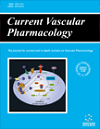- Home
- A-Z Publications
- Current Vascular Pharmacology
- Previous Issues
- Volume 3, Issue 1, 2005
Current Vascular Pharmacology - Volume 3, Issue 1, 2005
Volume 3, Issue 1, 2005
-
-
Micronized Purified Flavonoid Fraction (MPFF)*: A Review of its Pharmacological Effects, Therapeutic Efficacy and Benefits in the Management of Chronic Venous Insufficiency
More LessInitially, the progression of chronic venous insufficiency is related to venous hypertension. The earliest complaints or symptoms, as well as vessel wall deterioration, valve restructuring, and, eventually, varicose veins, result not only from elevation of pressure, but also from a cascade of biochemical events related to both the macro- and the microcirculation. Thickening and remodelling of the venous wall are influenced b Read More
-
-
-
Molecular Pathways of Endothelial Cell Activation for (Targeted) Pharmacological Intervention of Chronic Inflammatory Diseases
More LessIn chronic inflammatory conditions, endothelial cells actively recruit immune cells from the circulation into the underlying tissue and participate in angiogenesis to support the continuous demand for oxygen and nutrients. They do so in response to activation by cytokines and growth factors such as tumour necrosis factor α (TNFα), interleukin-1 (IL-1), vascular endothelial growth factor (VEGF), and fibroblast growth factors (F Read More
-
-
-
Evidence for, and Importance of, cGMP-Independent Mechanisms with NO and NO Donors on Blood Vessels and Platelets
More LessAuthors: Janet C. Wanstall, Kerry L. Homer and Sheila A. DoggrellIn the vasculature it is well established that cGMP is involved in the relaxant response to nitric oxide (NO) and NO donors. However, there is an increasing evidence that alternative / additional pathways that are cGMP-independent may also exist. A key criterion for a response to NO or a NO donor drug to be classified as cGMP-independent is lack of (or incomplete) inhibition by the selective inhibitor of soluble guanylate cyclas Read More
-
-
-
Transforming Growth Factor-β, Cell Signaling and Cardiovascular Disorders
More LessAuthors: Alex Agrotis, Natalia Kalinina and Alex BobikTransforming growth factor-beta (TGF-β) is a multifunctional growth factor with a wide range of potential effects on growth, differentiation, extracellular matrix accumulation and the immune system. It has been implicated in many cardiovascular disorders. TGF-β actions are mediated via a complex between its type I and type II receptors resulting in the phosphorylation of receptor-specific Smads followed by their pass Read More
-
-
-
Macrophage Activation in Atherosclerosis: Pathogenesis and Pharmacology of Plaque Rupture
More LessBy J. J. BoyleAtherosclerosis is still an important disease. It accounts for 39% of deaths in the U.K. and 12 million U.S citizens have atherosclerosis-associated disease. Atherosclerosis may exert clinical effects by slow narrowing, producing stable angina or dramatic rupture, producing acute coronary syndromes such as unstable angina or myocardial infarction and death. Macrophages are abundant in ruptured atherosclerotic plaques. Read More
-
-
-
Modulation of Cardiovascular Remodeling with Statins: Fact or Fiction?
More LessAuthors: Rajasekhar Reddy, Georges Chahoud and J. L. MehtaThe concept of cardiac remodeling implies a complex mixture of myocardial ischemia, and increased wall stress that results in molecular, cellular and interstitial changes in the heart. Clinically, cardiac remodeling is manifested as a change in size, shape and function of the heart. Morphologically the key feature of remodeling is myocyte hypertrophy, myocyte loss from necrosis or apoptosis, as well as interstitial ce Read More
-
-
-
Role of Vascular Nitric Oxide in Experimental Liver Cirrhosis
More LessOne of the most important features of liver cirrhosis is the splanchnic and systemic arterial vasodilation, related to an increase in vascular capacity and an active vasodilation. This arterial vasodilation seems to be the consequence of the excessive generation of vasodilating substances, which also contributes to a lower than normal pressor response to circulating nervous or humoral substances. The following review analyzes th Read More
-
-
-
Fenofibrate: Metabolic and Pleiotropic Effects
More LessDisturbances of lipoprotein metabolism represent one of the most important risk factors for vascular events. However, dyslipidaemic patients often have a number of additional abnormalities (such as endothelial dysfunction, hypertension, low-grade inflammation, haemostatic abnormalities and hyperuricaemia) that may accelerate the atherosclerotic process. Thus, the ideal lipid-modifying drug, along with exerting beneficial eff Read More
-
Volumes & issues
-
Volume 23 (2025)
-
Volume 22 (2024)
-
Volume 21 (2023)
-
Volume 20 (2022)
-
Volume 19 (2021)
-
Volume 18 (2020)
-
Volume 17 (2019)
-
Volume 16 (2018)
-
Volume 15 (2017)
-
Volume 14 (2016)
-
Volume 13 (2015)
-
Volume 12 (2014)
-
Volume 11 (2013)
-
Volume 10 (2012)
-
Volume 9 (2011)
-
Volume 8 (2010)
-
Volume 7 (2009)
-
Volume 6 (2008)
-
Volume 5 (2007)
-
Volume 4 (2006)
-
Volume 3 (2005)
-
Volume 2 (2004)
-
Volume 1 (2003)
Most Read This Month
Article
content/journals/cvp
Journal
10
5
false
en


